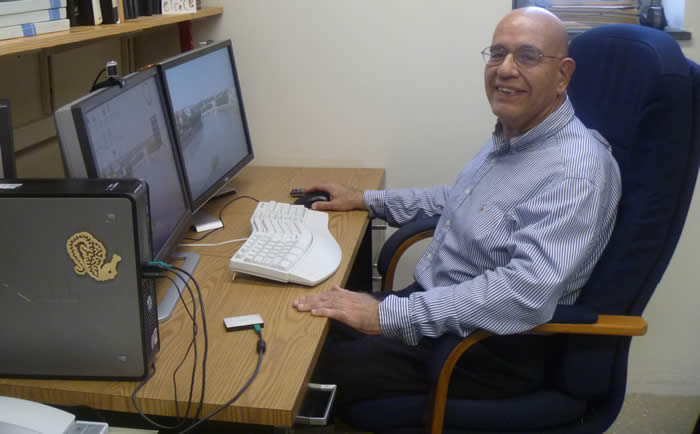Germán Barrionuevo, M.D.
Professor
Department of Neuroscience
University of Pittsburgh
Pittsburgh, Pennsylvania, U.S.A.
Basic Information:
Dr. Barrionuevo is Professor in the Department of
Neuroscience at the University of Pittsburgh Kenneth P. Dietrich School of Arts and Sciences. People working in this laboratory study synaptic
plasticity and biophysical properties of neurons in hippocampal area CA3.
Research Interests:
The hippocampus is a cortical
structure known to play a central role in the formation and tempory
storage of declarative memories. Indeed, damage to the hippocampal formation in humans and animal subjects results in
deficits to form long-term episodic memories. While the mechanisms allowing the
hippocampus to support the formation of such memories are still unknown, one key
assumption underlying many computational models of the hippocampus is that area
CA3 is capable of robust "pattern separation". Pattern separation refers to the
ability of the CA3 neuronal network to represent cortical activity while
minimizing overlap of cortical representations. Computer simulations indicate
that pattern separation can be achieved by coordinated activation of a weak and
diffuse input to convey the memory representation from the entorhinal cortex
(EC), and a strong but sparse input to select the subpopulations of CA3
pyramidal cells that establish non-overlapping memory representations via their
recurrent collaterals. Indeed, one unique feature of hippocampal CA3 pyramidal
cells is that they receive two converging excitatory inputs from EC. One input
is conveyed monosynaptically via the perforant path (PP), and is relatively weak
and diffuse. The second input from EC is conveyed disynaptically via the mossy
fibers (MF), the axons of dentate gyrus granule (DG) cells, and is sparse and strong. An
important issue is whether the sparseness and strength of the MF
synaptic input are the only features at play during pattern separation. For
example, MF innervate more interneurons than pyramidal cells; thus,
granule cell discharge exerts a strong inhibitory control over pyramidal cell
firing, which could further "sharpen" the focus of the MF excitatory drive onto the CA3 neuronal network.
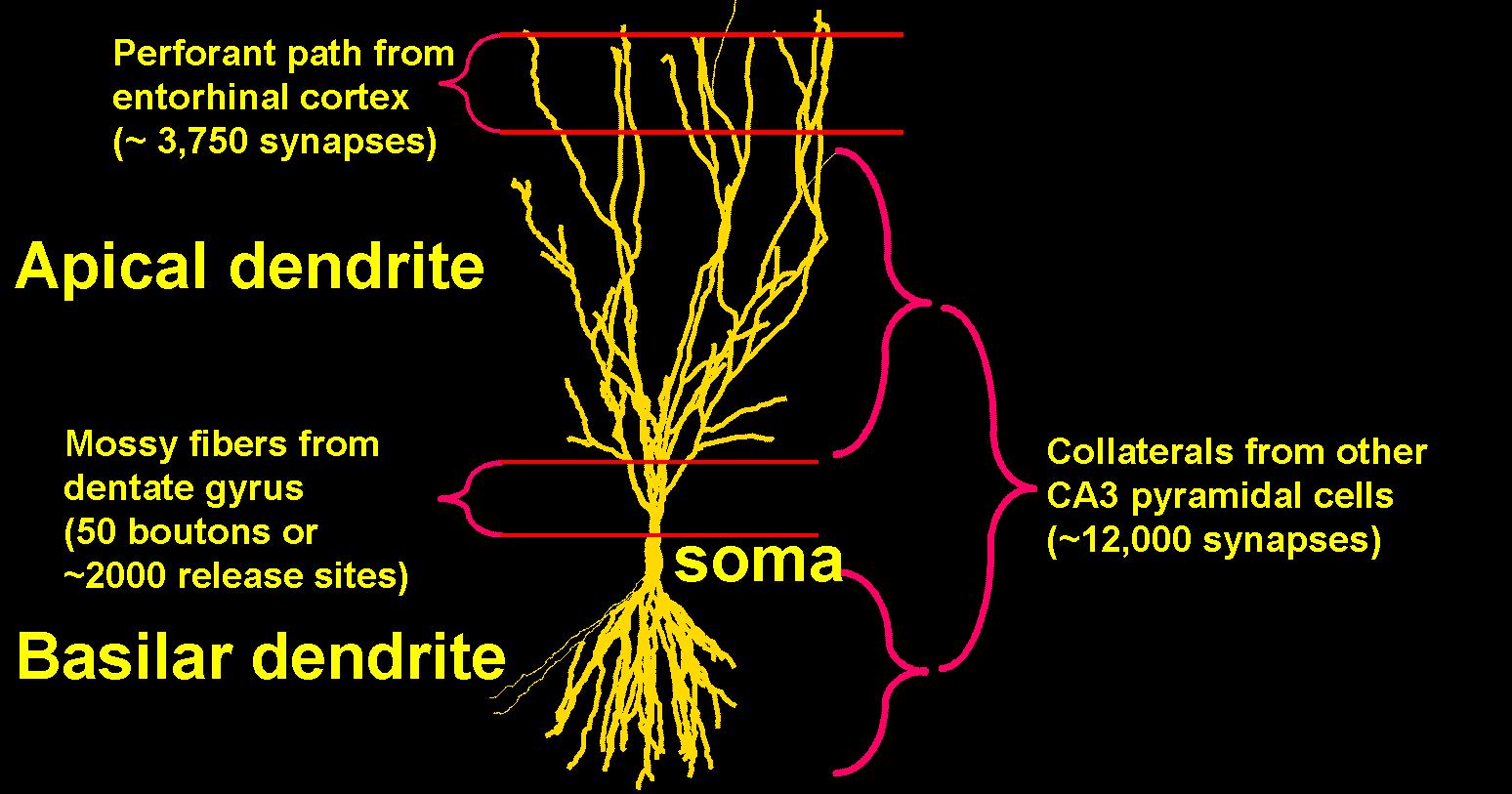
Quantitative Summary of the Excitatory Synaptic Inputs to CA3 Pyramidal Cells
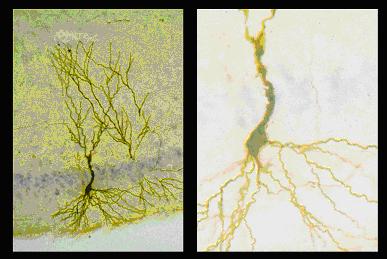
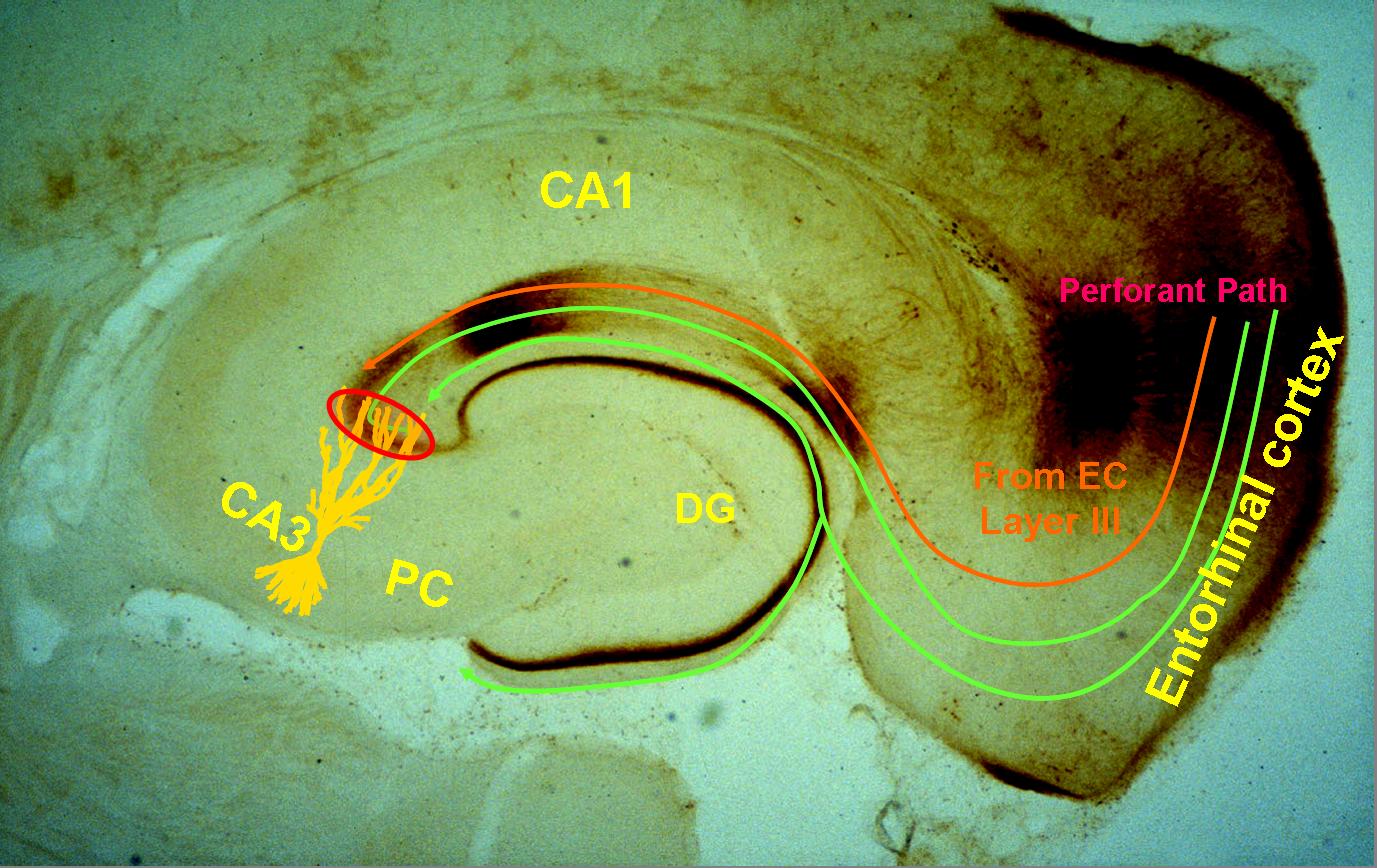
The Trajectory of the Biocytin Labeled Perforant Path Projection to the Hippocampal Formation
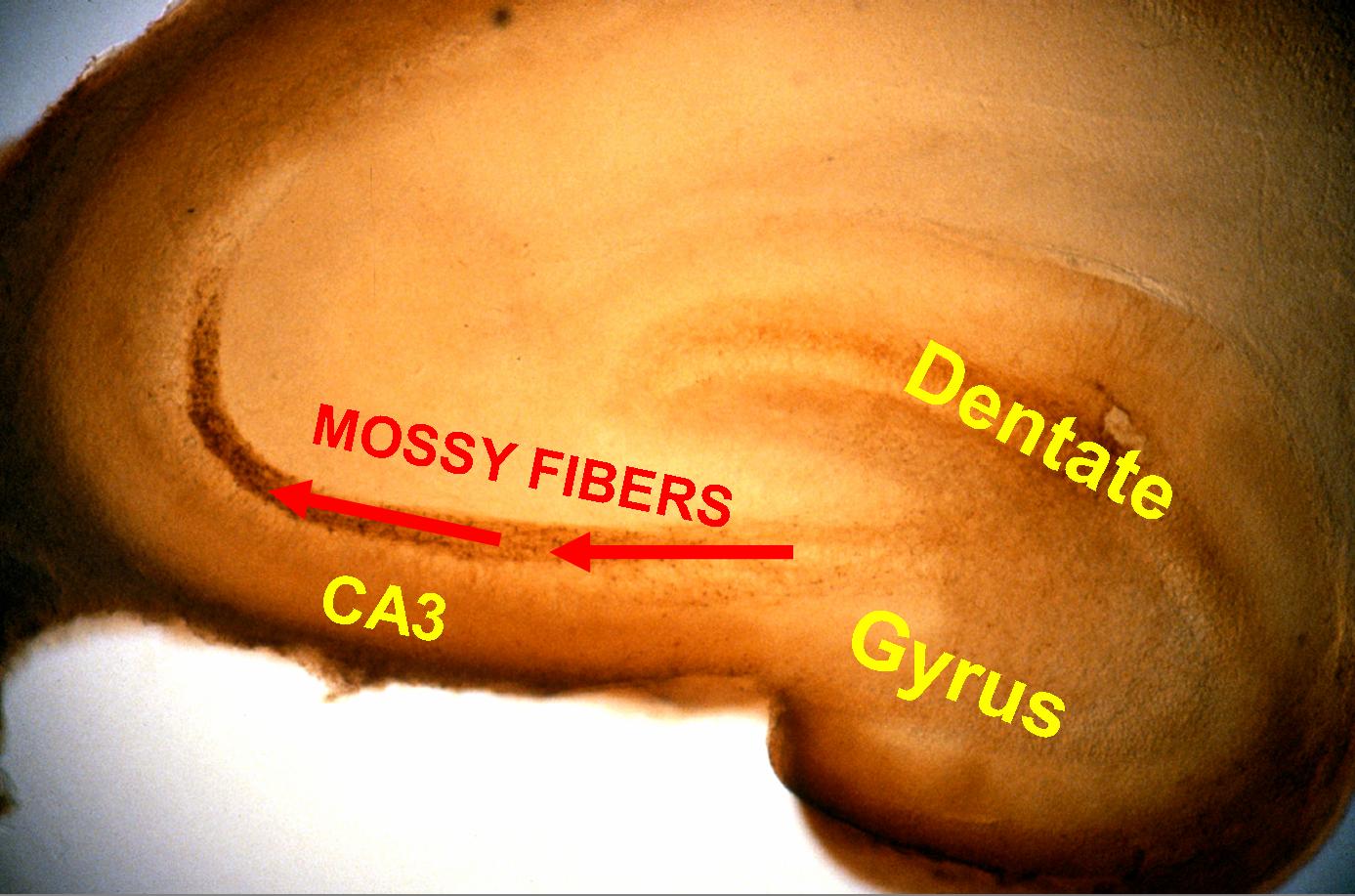
The Trajectory of Biocytin Labeled Mossy Fibers in Area CA3
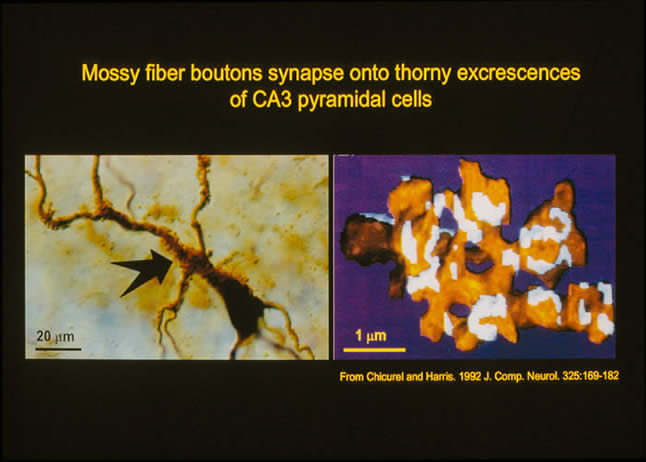
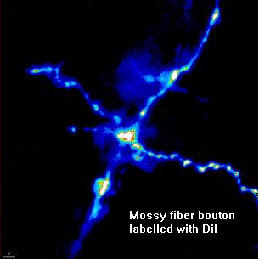
Long-Term Plasticity at Mossy Fiber Synapses on CA3 Cells
One long-standing hypothesis in the study of the biological
mechanisms of memory storage is that the formation of new memories requires
long-lasting synaptic modification. In the hippocampus, long-term potentiation (LTP)
and depression (LTD) of synaptic strength has been widely studied as a possible
mechanism of memory storage. LTP is a persistent increase in synaptic efficacy
that can be induced by brief high frequency stimulation (HFS) of a glutamatergic
input to a neuron. Generally, cortical LTP induction of AMPA receptor-mediated synaptic responses is NMDA receptor-dependent; however, at MF synapses on CA3 pyramidal cells LTP is NMDA receptor-independent and is preceded by a large posttetanic potentiation (PTP).
A substantial body of evidence indicates that MF synaptic plasticity also can be expressed at excitatory inputs to interneurons in area CA3 and dentate gyrus. Because interneurons are major regulators of principal cell output, long-term changes in the efficacy of their excitatory input will affect pattern separation, the generation of rhythmic oscillations of large populations of both principal cells, and other populations of inhibitory interneurons. The extensive heterogeneity in interneuron plasticity thus far described constitutes a major obstacle for the development of a single general principal to account for the synaptic efficacy changes in these cells.

Micrographs of CA3 Interneurons Labeled with Biocytin (left column) along with their Digital Reconstructions (right column) (for more details click here).
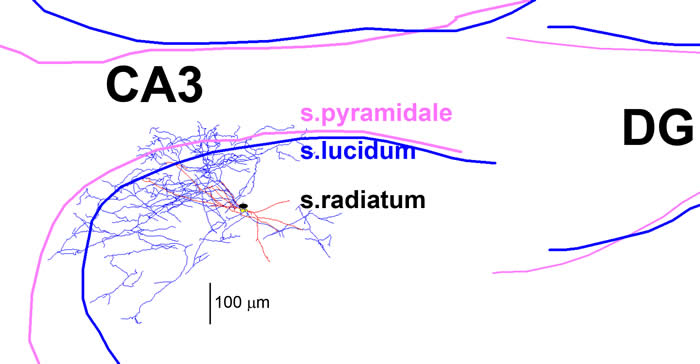
Digitally Reconstructed CA3 Interneuron with Soma in the Stratum Radiatum (for more details click here).
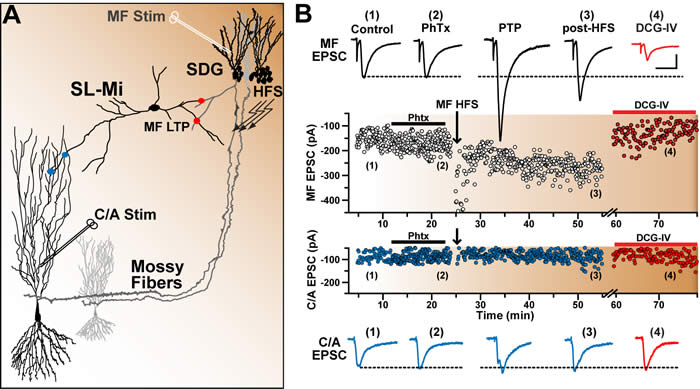
LTP at Mossy Fiber Synapses on Feed-forward Inhibitory Interneurons with Soma Location in the Stratum Lacunosum-Moleculare (SL-Mi) of Area CA3 is Input Specific and Expressed at Predominantly CI-AMPAR Synapses (for more details click here).

The Mechanisms of Bidirectional Plasticity at Mossy Fibers en
passant Synapses on the Spineless Dendrite
of L-M Interneurons (for more details click here). This form of MF LTP is dependent on postsynaptic activation of PKA and PKC.
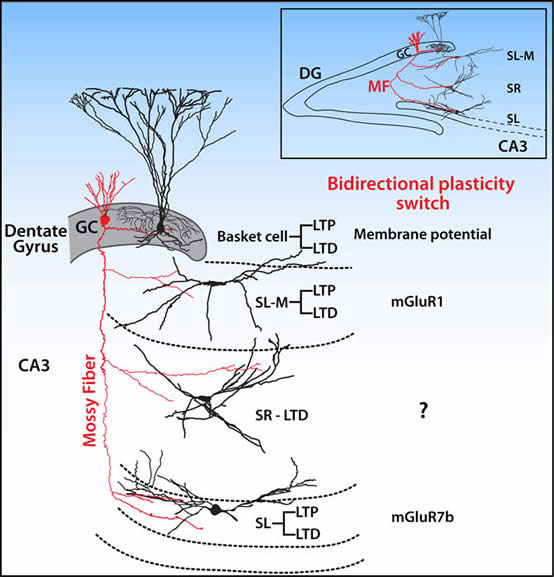
Hippocampal Mossy Fibers Synapses on Interneurons Exhibit Multiple Forms of Long-Term Synaptic Plasticity (for more details click here)

Compartmentalized Signaling Cascades for LTP Induction at RC and MF Synapses on the Spiny Dendrite of CA3 SR/L-M Interneurons (for more details click here)
Representative Publications:
Langdon R. B., Johnson J. W., and Barrionuevo, G. (1995) Posttetanic Potentiation and Presynaptically Induced Long-Term Potentiation at the Mossy Fiber Synapse in Rat Hippocampus. Journal of Neurobiology 36:370-385.
Henze, D.A., Cameron, W.E., and Barrionuevo, G. (1996) Dendritic morphology
and its effects on the amplitude and rise time of synaptic signals in
hippocampal CA3 pyramidal cells. Journal of Comparative Neurology 369:
331-344.
Urban, N.N. and Barrionuevo, G. (1996)
Induction of Hebbian and non Hebbian Mossy Fiber LTP by Distinct Patterns of High Frequency Stimulation. Journal of Neuroscience 16: 4293-4299.
Urban, N.N., Henze, D.A., Lewis, D.A., and Barrionuevo, G. (1996)
Properties of LTP Induction in the CA3 Region of the Primate Hippocampus. Learning and Memory
3: 86-95.
Henze, D.A., Card, J.P., Barrionuevo, G., and Ben-Ari, Y. (1997)
Large Amplitude Miniature Excitatory Postsynaptic Currents in Hippocampal CA3 Pyramidal Neurons are of Mossy Fiber Origin. Journal of Neurophysiology 77: 1075-1086.
Henze, D.A., Urban, N.N., and Barrionuevo, G. (1997) Origin of the Apparent
Asynchronous Activity of Hippocampal Mossy Fibers. Journal of Neurophysiology
78: 24-30.
Berzhanskaya, J., Urban, N.N., and Barrionuevo, G. (1998) Pharmacological
Characterization of the Monosynaptic Perforant Path Input to CA3 Pyramidal
Neurons. Journal of Neurophysiology 79: 2111-2118.
Urban, N.N., Henze, D.A., Barrionuevo, G. (1998) Amplification of Perforant
path EPSPs in CA3 Pyramidal Cells by LVA Calcium and Sodium Channels. Journal of
Neurophysiology 80:1558‑1561.
Urban, N.N., and Barrionuevo, G. (1998) Active Summation of EPSPs in CA3
Pyramidal Neurons. Proceedings of the National Academy of Sciences (USA) 95:11450-11455.
Kanterewicz, B.I., Urban N.N., McMahon, D.B.T., Norman, E.D., Givven, L.J., Scherle, P.A., Barrionuevo, G., and Klann, E. (2000) The Extracellular Signal-regulated Kinase Cascade is Required for NMDA Receptor-independent LTP in Area CA1 but not Area CA3 of the Hippocampus. Journal of Neuroscience 20: 3057-3066, 2000.
Henze, D. A., Urban, N.N., and Barrionuevo, G. (2000) The Multifarious Hippocampal Mossy Fiber Pathway: A Review. Neuroscience 98: 407-427.
Urban, N.N., Henze, D. A., and Barrionuevo, G. (2001) Revisiting the Role of the Hippocampal Mossy Fiber Synapse. Hippocampus 11:408-417.
Henze, D. A., McMahon, D., Harris, K. M., and Barrionuevo, G. (2002) Giant Miniature EPSCs at the Hippocampal Mossy Fiber to CA3 Pyramidal Cell Synapse Are Monoquantal. Journal of Neurophysiology 87:15-29.
Calixto, E., Thiels, E., Klann, E. and Barrionuevo, G. (2003) Early Maintenance of Hippocampal Mossy Fiber-LTP Depends on Protein and RNA Synthesis and Presynaptic Granule Cell Integrity. Journal of Neuroscience. 23: 4842-4849.
Krimer, L.S., Zaitsev, A.V., Czanner, G., Kröner, S., González-Burgos,G., Povysheva1, N.V., Iyengar, S., Barrionuevo, G., and Lewis D.A.(2005) Cluster Analysis-based Physiological Classification and Morphological Properties of Interneurons in Layers 2-3 of Monkey Dorsolateral Prefrontal Cortex. Journal of Neurophysioloty 94:3009-3022.
Calixto, E., Galván E.J., Card, J.P. and Barrionuevo, G. (2008) Coincidence Detection of Convergent Perforant Path and Mossy Fibre Inputs by CA3 Interneurons. Journal of Physiology 586: 2695-2712.
Galván, E.J, Calixto, E. and Barrionuevo, G. (2008) Bidirectional Hebbian Plasticity at Mossy Fiber Synapses on CA3 Interneurons. Journal of Neuroscience 28:14042-14055.
Ascoli, G.A., Brown, K.A., Calixto, E., Card, J.P., Galván, E.J., Perez-Rosello, P., and Barrionuevo, G. (2009) Quantitative Morphometry of Electrophysiologically Identified CA3b Interneurons Reveals Robust Local Geometry and Distinct Cell Classes. Journal of Comparative Neurology 515: 677–695.
Cosgrove, K.E., Galván, E.J., Meriney, S.D., and Barrionuevo, G. (2010). Area CA3 Interneurons Receive Two Spatially Segregated Mossy Fiber Inputs. Hippocampus 20: 1003-1004.
Galván E.J., Cosgrove, K.E., Mauna, J.C., Card, J.P., Thiels, E., Meriney, S.D., and Barrionuevo, G. (2010) Critical Involvement of Postsynaptic Kinase Activation in LTP at Hippocampal Mossy Fiber Synapses on CA3 Interneurons. Journal of Neuroscience 30: 2844-2855.
Cosgrove, K.E., Meriney, S.D., and Barrionuevo, G. (2010). High Affinity Group III mGluRs Regulate Mossy Fiber Input to CA3 Interneurons. Hippocampus 21:1302-1317.
Perez-Rosello T., Baker, J. L., Ferrante M., Iyengar S. Ascoli G.A., and Barrionuevo, G. (2011) Passive and Active Shaping of Unitary Responses from Associational/Commissural and Perforant Path Synapses in Hippocampal CA3 Pyramidal Cells. Journal of Computational Neuroscience 31:159-182.
Baker J. L., Perez-Rosello T., Migliore M. A., Barrionuevo, G., and Ascoli G.A. (2011) Computer Model of Unitary Responses from Associational/Commissural and Perforant Path Synapses in Hippocampal CA3 Pyramidal Cells. Journal of Computational Neuroscience 31:137-158..
Galván E.J., Cosgrove K.E., and Barrionuevo, G. (2011). Multiple Forms of Long-Term Synaptic Plasticity at Hippocampal Mossy Fibers Synapses on Interneurons. Neuropharmacology 60: 740-747.
Cosgrove K.E., Galván E.J., Barrionuevo, G., and Meriney S.D. (2011) mGluRs Modulate Strength and Timing of Excitatory Transmission in Hippocampal Area CA3. Molecular Neurobiology 44:93-101.
Anderson W., Galván E.J., Mauna J.C., Thiels E., and Barrionuevo G. (2011) Properties and Functional Implications of Ih in Hippocampal Area CA3 Interneurons. Pflügers Archiv - European Journal of Physiology 462:895-912. 10.1007/s00424-011-1025-3.
Galvan E.J., Pérez-Rosello T., Gómez-Lira G., Lara E., Gutiérrez R., and Barrionuevo G. (2015) Synapse-Specific Compartmentalization of Signaling Cascades Neuroscience 290: 332-345.
Contact Information:
University of Pittsburgh
Department of Neuroscience
A210 Langley Hall
Pittsburgh, PA 15260
Voice: (412) 624-7330
Fax: (412) 624-9198
email: german@pitt.edu
Affiliations:
Please visit the Department
of Neuroscience home page.
These pages are maintained by German Barrionuevo.
Please e-mail your comments.
Last updated on
March 3, 2015
